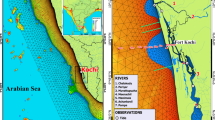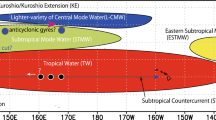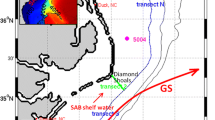Abstract
A high-resolution coastal ocean model was developed to simulate the temporal/spatial variability of the Kennebec–Androscoggin (K–A) river plume and the circulation in Casco Bay. The model results agree favorably with the moored and shipboard observations of velocity, temperature, and salinity. The surface salinity gradient was used to distinguish the plume from the ambient coastal water. The calculated plume thickness suggests that the K–A plume is surface trapped. Its horizontal scales correlate well with Q 0.25, where Q is the volume discharge of the rivers. Directional spreading is affected by the wind with the upwelling favorable wind transporting the plume water offshore. Both the wind and the tide also enhance mixing in the plume. The inclusion of a wetting-and-drying (WAD) scheme appears to enhance the mixing and entrainment processes near the estuary. The plume becomes thicker near the mouth of the estuary, the outflow velocity of the plume is weaker, and the radius of the river plume shrinks. The flow field in the model run with the WAD is noisier, not only in shallow areas of Casco Bay but also in the plume and even on the shelf. We speculate that the WAD processes can affect much larger areas than the intertidal zones, especially via a river plume that feeds into a coastal current.












Similar content being viewed by others
References
Avicola G, Huq P (2003) The characteristics of the recirculating bulge region in coastal buoyant outflows. J Mar Res 61:435–463
Balzano A (1998) Evaluation of methods for numerical simulation of wetting and drying in shallow water flow models. Coast Eng 34:83–107
Casco Bay Estuary project (1995) Draft Casco Bay plan. pp 217
Chant RJ, Wilkin J, Zhang W, Choi B-J, Hunter E, Castelao R, Glenn S, Jurisa J, Schofield O, Houghton R, Kohut J, Frazer TK, Moline MA (2008) Dispersal of the Hudson River plume in the New York Bight: synthesis of observational and numerical studies during LaTTE. J Oceanogr 21:148–161
Chao S-Y, Boicourt WC (1986) Onset of estuarine plumes. J Phys Oceanogr 16:2137–2149
Choi B, Wilkin L (2007) The effect of wind on the dispersal of the Hudson River plume. J Phys Oceanogr 37:1878–1897
Cousins, S, Xue H, Pettigrew N, Mickelson M (2006) Responses of the Gulf of Maine to Northeasters in May 2005—a case study using the GoMOOS nowcast/forecast System. Poster presented at the 2006 Ocean Sciences Meeting, Honolulu, HI
Du Y (2008) Implementation of a wetting and drying model in simulating the Androscoggin/Kennebec plume and the circulation in Casco Bay. M.S. thesis, University of Maine, p 56
Fong DA, Geyer WR, Signell RP (1997) The wind-forced response on a buoyant coastal current: observation of the west Maine coastal plume. J Mar Syst 12:69–81
Fong DA, Geyer WR (2001) Response of a river plume during an upwelling favorable wind event. J Geophys Res 106:1067–1084
Garvine RW (1987) Estuary plumes and fronts in shelf waters: a layer model. J Phys Oceanogr 17:1877–1896
Garvine RW (1995) A dynamical system for classifying buoyant coastal discharges. Cont Shelf Res 15:1585–1596
Garvine RW (2001) The impact of model configuration in studies of buoyant coastal discharge. J Mar Res 59:193–225
Geyer WR, Signell RP, Fong DA, Wang J, Anderson DM, Keafer BA (2004) The freshwater transport and dynamics of the western Maine coastal current. Cont Shelf Res 24:1339–1357
Hetland RD (2005) Relating river plume structure to vertical mixing. J Phys Oceanogr 35:1667–1688
Hickey BM, Pietrafesa LJ, Jay DA, Boicourt WC (1998) The Columbia River plume study: subtidal variability in the velocity and salinity fields. J Geophys Res 103:10339–10368
Hickey BM, Geier S, Kachel N, MacFadyen A (2005) A bi-directional river plume: the Columbia in summer. Contl Shelf Res 25:1631–1656
Horner-Devine AR (2009) The bulge circulation in the Columbia River plume. Cont Shelf Res 29:234–251
Janzen CD, Churchill JH, Pettigrew NR (2005) Observations of exchange between eastern Casco Bay and the western Gulf of Maine. Deep-Sea Res II 52:2411–2429
Keafer BA, Churchill JH, Anderson DM (2005) Blooms of the toxic dinoflagellate, Alexandrium fundyense in the Casco Bay region of the western Gulf of Maine: advection from offshore source populations and interactions with the Kennebec River plume. Deep-Sea Res II 52:2631–2655
Mellor GL, Yamada T (1982) Development of a turbulence closure model for geophysical fluid problems. Rev Geophys Space Phys 20:851–875
Mellor GL (2002) Oscillatory bottom boundary layers. J Phys Oceanogr 32:3075–3088
Mellor GL (2004) Users guide for a three-dimensional, primitive equation, numerical ocean model. Princeton University, Princeton, p 56
Mendelsohn D, Yassuda E, Peene S (2001) A simplified method for marsh inundation modelling in hydrodynamic and water quality models with application to the Cooper river Estuary (SC). Proceedings of the 7th International Conference on Estuarine and Coastal Modelling, pp 654–669
O’Donnell J (1990) The formation and fate of a river plume: a numerical model. J Phys Oceanogr 20:551–569
Oey L (2005) A wetting and drying scheme for POM. Ocean Model 9:133–150
Oey L (2006) An OGCM with movable land–sea boundaries. Ocean Model 13:176–195
Oey L, Ezer T, Hu C, Muller-Karger FE (2007) Baroclinic tidal flows and inundation processes in Cook Inlet, Alaska: numerical modeling and satellite observations. Ocean Dynamics 57:205–221
Parker CE (1982) The currents of Casco Bay and the prediction of oil spill trajectories. Technical report no. 28, Bigelow Laboratory for Ocean Sciences. Prepared for the State of Maine, State Planning Office.
Pettigrew N, Churchill JH, Janzen CD, Mangum L, Signell RP, Thomas A, Townsend DW, Wallinga JP, Xue H (2005) The kinematic and hydrographic structure of the Gulf of Maine coastal current. Deep-Sea Res II 52:2369–2391
Pinones A, Valle-Levinson A, Narvaez DA, Vargas CA, Navarrete SA, Yuras G, Castilla JC (2005) Wind-induced diurnal variability in river plume motion. Estuar Coast Shelf Sci 65:513–525
Raineault NA (2006) Temporal and spatial variability of surface meteorological conditions over the Gulf of Maine: comparisons of the National Data Buoy Center observations and Eta model results. Honors thesis, University of Maine, p 38
Uchiyama Y (2004) Wetting and drying scheme for POM and its application to San Francisco Bay. In: Cheng L, Yeow K (eds) Hydrodynamics VI—theory and application. Taylor & Francis Group, London, pp 293–299
Xie L, Pietrafesa LJ, Peng M (2004) Incorporation of a mass-conserving inundation scheme into a three-dimensional storm surge model. J Coast Res 20:1209–1223
Xue H, Shi L, Cousins S, Pettigrew NR (2005) The GoMOOS nowcast/forecast system. Cont Shelf Res 25:2122–2146
Yankovsky A, Chapman DC (1997) A simple theory for the fate of buoyant coastal discharges. J Phys Oceanogr 27:1386–1401
Acknowledgments
The authors would like to thank Dr. Joseph Salisbury of the Coastal Ocean Observing Center at the University of New Hampshire, Dr. Neal Pettigrew, and the GoMOOS buoy group for providing the cruise and mooring data used in this study. Two anonymous reviewers provided many valuable comments and suggestions, and their efforts are gratefully acknowledged. This study was supported by subcontracts of NASA Grant NNX08AC27G and NOAA Grant NA04NOS4780271 to the University of Maine.
Author information
Authors and Affiliations
Corresponding author
Additional information
Responsible Editor: Leo Oey
Rights and permissions
About this article
Cite this article
Xue, H., Du, Y. Implementation of a wetting-and-drying model in simulating the Kennebec–Androscoggin plume and the circulation in Casco Bay. Ocean Dynamics 60, 341–357 (2010). https://doi.org/10.1007/s10236-010-0269-3
Received:
Accepted:
Published:
Issue Date:
DOI: https://doi.org/10.1007/s10236-010-0269-3




